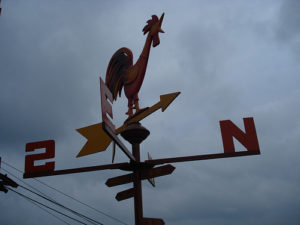 This guest post is especially relevant for me right now due to the fact that I am working on expanding my own artistic repertoire. Although I still enjoy painting my artistic subject matter, I have become a bit bored and I want to spice it up!
This guest post is especially relevant for me right now due to the fact that I am working on expanding my own artistic repertoire. Although I still enjoy painting my artistic subject matter, I have become a bit bored and I want to spice it up!
To do this, I have begun taking private abstract painting classes as well as an encaustic workshop that starts later this week. My goal is to learn a few new techniques that will add a new dimension to my work without confusing my collectors, my galleries or me! I think I am on the right track…I will keep you posted on my progress.
Guest Author: The following post was originally on ArtBistro.Monster.com
There may be some new creative projects that you want to begin or some new ways of marketing and promoting yourself that you know would be smart to attempt but something seems to be holding you back. Here are ten tips for expanding your repertoire of artistic projects and/or self-promotional efforts.
1. Know what you currently do
Because our lives rush along, providing us with no chance to catch up with ourselves, we often don’t really know what we’ve been attempting or accomplishing. When was the last time you had a conversation with yourself about what sort of art you’re making or what sort of marketing efforts you’re attempting? It’s harder to know what new things to try if you don’t know what current things you’re doing. Settle in and spend real time discerning your current situation.
2. Detach from the idea of “one way”
In part because it reduces our experience of anxiety, we often decide to do things one way — paint one sort of painting, market in one particular way—and then refuse to think about or discount the desirability of other art or marketing efforts that we might make. Maybe we think that only the gallery scene is for us and that marketing our art online is beneath our dignity. Try to let go of the idea that there is just one way to do things and find the courage to investigate other ways of making art and marketing art, even those that at first glance look completely uncongenial.
3. Investigate your dislikes
If you dislike realistic painting, why do you dislike it? If you dislike abstract painting, why do you dislike it? If you dislike talking to gallery owners, why do you dislike those interactions? If you dislike studio visits, why do you dislike them? We often make snap judgments about our likes and dislikes and subsequently never investigate those like and dislikes again, responding instead with a knee-jerk reaction. Take a good, hard look at those things you claim to dislike and see if they really are so unlikeable.
4. Investigate your fears
We often hide from ourselves the fact that something is making us scared or anxious. Maybe we have real fears that our drawing skills aren’t up to snuff but keep dodging that painful information and paint abstractly not because we genuinely want to paint abstractly but because we know that our realistic paintings wouldn’t measure up. It is very brave work but very valuable work to look your fears and anxieties in the eye. Only then will you understand your true situation. That understanding is bound to open the door to courageous new efforts.
5. Articulate your possibilities
What new art do you want to attempt? What new marketing efforts do you want to try? If you don’t get them named, it’s unlikely that you can pursue them. If, on the other hand, you can say clearly to yourself that you want to try your hand at some Calder-esque mobiles or that you want to learn how to affiliate market your paintings, that clarity of expression will help you begin to move in new directions.
6. Make a strong choice
Let’s say that you have several kinds of new art that you want to make: a venture into sculpture, a multi-media project, some monoprinting, a new style involving personal history, and so on. It is exciting to want to do many things but it can also prove paralyzing to have too many simultaneous choices. Choose something strongly without second-guessing whether it is the best choice and without grieving that you can’t do x or y today because you are doing z. Until we make strong choices of this sort, we tend not to get anything done.
7. Stretch in a new direction
If you’re moving in a genuinely new direction, that movement is likely to feel risky as well as exciting. Remember that risky things actually feel risky in the body! Don’t be surprised if your stomach gets queasy or your palms sweat—and don’t use those feelings as excuses to stop what you’re attempting. Instead say, “Okay, I’m making myself anxious here—and that’s okay. Onward!” If you’ve been painting your whole life and now you’re starting to sculpt, isn’t it likely that that will feel like a stretch? Accept that reality.
8. Accept being a beginner
If you are trying something genuinely new, say for example moving from watercolors to acrylics or moving from studio visits only to gallery efforts, you must accept that you are a beginner and that you will stammer more than you would like, stub your toe more than you would like, and on some days feel completely lost at sea. Do not let these realities become the excuses you use to return to more familiar ways. Expect them, accept them, and persevere!
9. Accept the reality of learning curves
Not only may you be a genuine beginner at this new painting style or marketing technique, you will also have to endure the learning curve that comes with any new effort. Just picture the learning curve required to go from first piano lessons to playing Bach at Lincoln Center! Don’t let the fact that a learning curve is coming daunt you or deter you. Accept the reality, forgive yourself on those days when you make “too little” progress, and keep the payoff in mind—your growth and success as an artist.
10. Use what you already know
Even though you may be a beginner at some new painting technique, painting style, or marketing strategy, you are not a beginner at life. You can parlay all that you’ve learned over the years and make your current experience easier than it might otherwise have been if you had been a novice at life. If you remind yourself that you know a lot and that you intend to bring all that knowing to your current efforts, you will do a better job of maintaining your enthusiasm, optimism, and focus.
*****
Let’s meet on Twitter, Facebook and now on Google Plus! http://gplus.to/lorimcnee ! (If you need a G+ invite, email me your gmail address!) BTW, here are my paintings, please visit LoriMcNee.com
…and here are some other inspiring articles I hope you enjoy! ~Lori 🙂
10 Tips to Find Your Own Artistic Voice
Should Artists Have Their Own Blogs?
Top 10 Ways to Improve Your Art
3 Steps to Find Art Gallery Representation
Focus and Plan to Paint
10 Tips to Handle a Creative Disaster
How Do You Define Success as an Artist?
Use the Hidden Meaning of Color to Improve Paintings
Creating Art in Small Studios
One Simple and Effective Way to Show the World You are a Pro
How to Choose Better Subject Matter for Your Art













Hi Lori !
This was a really great read . It is funny, but while reading this , I could hear my Dad saying years ago to me “Debb you are learning something else new to do? When are you going to find the time to try something new ?”…I still chuckle over him saying this, but this is who I am. I truly believe I was born to create, and I SURE LOVE THE FREEDOM OF IT and that I LOVE!!
. I was lucky straight out of high school to land a creative job at a sign shop, and still love what I’m doing, because of so many different ways to create, and teach myself better skills in how to make it better. I do the same thing with my art work/ paintings. I was pleased to hear Lori that you are giving “abstract painting” a try. This thing about painting one specific subject matter for galleries has never sat good with me…we are creative people-try new things-explore-have a blast-get messy, what’s wrong with that? “Not one thing” I say…:) I have always used abstract as a way of warming me up for my realistic paintings…and while being so free, it gets all the “cobwebs” out of my head.
I have the same rules as any other paintings we do…have a good design !
Happy painting and keep these great articles coming !
Hugs,
Debb
Ps..I believe more people are promoting online, than being in galleries ,because they can !! And it is up to “us” to market & push ourselves as far as we can go…who can explain our paintings , more than ourselves…Right ! The sky is the limit my friend !
Hello Deb-
Yes, my dad and mom have told me similar things to your dad’s words…
I am loving abstract art! It is loosening up and richening my realistic work. I can’t wait to get a new body of work together. I hope to post something on FB soon…
Thanks for the comment and the t-shirt that just arrived! It took so long to get here, but I love it!
Hugs-
Lori
This post makes a great encouraging and focusing daily reading.
Wonderful Moish, reading is one of the best ways to learn!
Happy creating-
Lori
Hello Lori……..I’m looking for some good advice on searching for an excellent web host for my art webpage.
Any suggestions?
Hello Chris,
Are you working in WordPress? You could start with GoDaddy or Host Gator and ask questions to make sure they will offer what you need. Will you have access to your own FTP? What bandwidth do you need? How many visitors do you have? What is the reliability, speed and security? Do some research, make some calls and ask your webmaster for help.
http://www.thesitewizard.com/webhosting/fine-print-resource-usage-limits.shtml
Good luck!
Lori
Lori –
Sooo nice to hear you finally got it Lori 🙂
I look forward to seeing a pic of you in it 🙂 , painting of course !
We all need ways to get our juices flowing so to speak with new ideas , surroundings , music, whatever works ! But there isn’t enough hours in a day it seems sometimes…keep up the great work Lori !!
Hugs,
Debb
Hi Debb,
Thanks for taking time to comment. I really appreciate all the love and support you give!
Hugs back-
Lori
Love your wisdom, Lori! So glad I found your site. I wonder if you would consider adding my latest blog to your guest articles? It’s called Ten Ways to Become A Professional Artist. Thanks, Janet